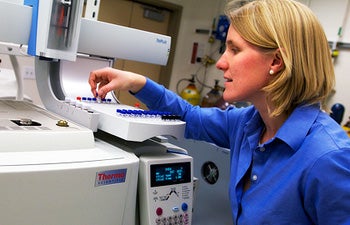Antarctica Warmer 20 Million Years Ago
Ancient Antarctica was warmer and wetter than previously suspected, enough to support vegetation along its edges, according to a new study led by USC Dornsife’s Sarah Feakins.
By examining the remnants of plant leaf wax found in sediment cores taken below the Ross Ice Shelf, scientists from USC, Louisiana State University and NASA’s Jet Propulsion Laboratory (JPL) determined that summer temperatures along the Antarctic coast 15 to 20 million years ago were 20 degrees Fahrenheit warmer than they are today, reaching up to about 45 degrees Fahrenheit. There was also several times more rain.
This occurred during a period of global warming in the middle Miocene epoch that coincided with increased levels of atmospheric carbon dioxide.
“This is some of the first evidence of just how much warmer it was,” said Feakins, an assistant professor of earth sciences in USC Dornsife and lead author of a paper on the research published in Nature Geoscience June 17.
Scientists began to suspect that high-latitude temperatures during the middle Miocene were warmer than previously believed when Sophie Warny, co-author of the Nature Geoscience paper, discovered large quantities of pollen and algae in sediment cores taken around Antarctica.
Fossils of plant life in Antarctica are difficult to come by because the movement of the massive ice sheets covering the landmass grinds and scrapes away the evidence.
“Deep sea cores are ideal to look for clues of past vegetation as the fossils deposited are protected from ice-sheet advances, but these are technically very difficult to acquire in the Antarctic and require international collaboration,” said Warny, assistant professor of palynology at Louisiana State University.

USC Dornsife’s Sarah Feakins, assistant professor of earth sciences, analyzes leaf wax hydrogen isotopic ratios on the Thermo-Finnegan gas chromatograph isotope ratio mass spectrometer in her laboratory at USC. The lead author of a paper published in the June 17 issue in Nature Geoscience showed how ancient Antarctica was warmer and wetter than previously suspected. Photo by Dietmar Quistorf.
“Ice cores can only go back about one million years,” Feakins said. “Sediment cores allow us to go into ‘deep time.’ ”
Tipped off by the tiny pollen samples, the USC Dornsife-led team opted to look at the remnants of leaf wax taken from sediment cores for clues. Leaf wax acts as a record of climate change by documenting details about the hydrogen isotope ratios of the water the plant drank while it was alive.
Jung-Eun Lee, a JPL scientist and another co-author on the paper, created model experiments to find out just how much warmer and wetter climate may have been.
“When the planet heats up, the biggest changes are seen toward the poles,” Lee said. “The southward movement of rain bands made the margins of Antarctica less like a polar desert, and more like present-day Iceland.”
The peak of Antarctic greening during this time period, known as the middle Miocene, occurred between 16.4 and 15.7 million years ago. For reference, this was well after the age of the dinosaurs, which died out 64 million years ago. During the Miocene epoch, mostly modern looking animals such as three-toed horses, deer and camel roamed Earth. Various species of apes also existed, though modern humans did not appear until 200,000 years ago.
Warm conditions during the middle Miocene are thought to be associated with carbon dioxide levels, probably around 400 to 600 parts per million (ppm). In 2012, carbon dioxide levels have climbed to 393 ppm, the highest they’ve been in the past several million years. At the current rate of increase, atmospheric carbon dioxide levels are on track to reach middle Miocene levels by the end of this century.
The ultimate goal of the study was to better understand what climate change may look like in the future, Feakins said.
“Just as history has a lot to teach us about the future, so does past climate: what this record shows us is how much warmer and wetter it can get around the Antarctic ice sheet as the climate system heats up.”
The research was funded by the US National Science Foundation with additional support from NASA.
“You might wonder: why does the middle Miocene matter?” Feakins said. “It’s a good analog to where carbon dioxide levels are headed. It shows what kind of dramatic changes are in store.”